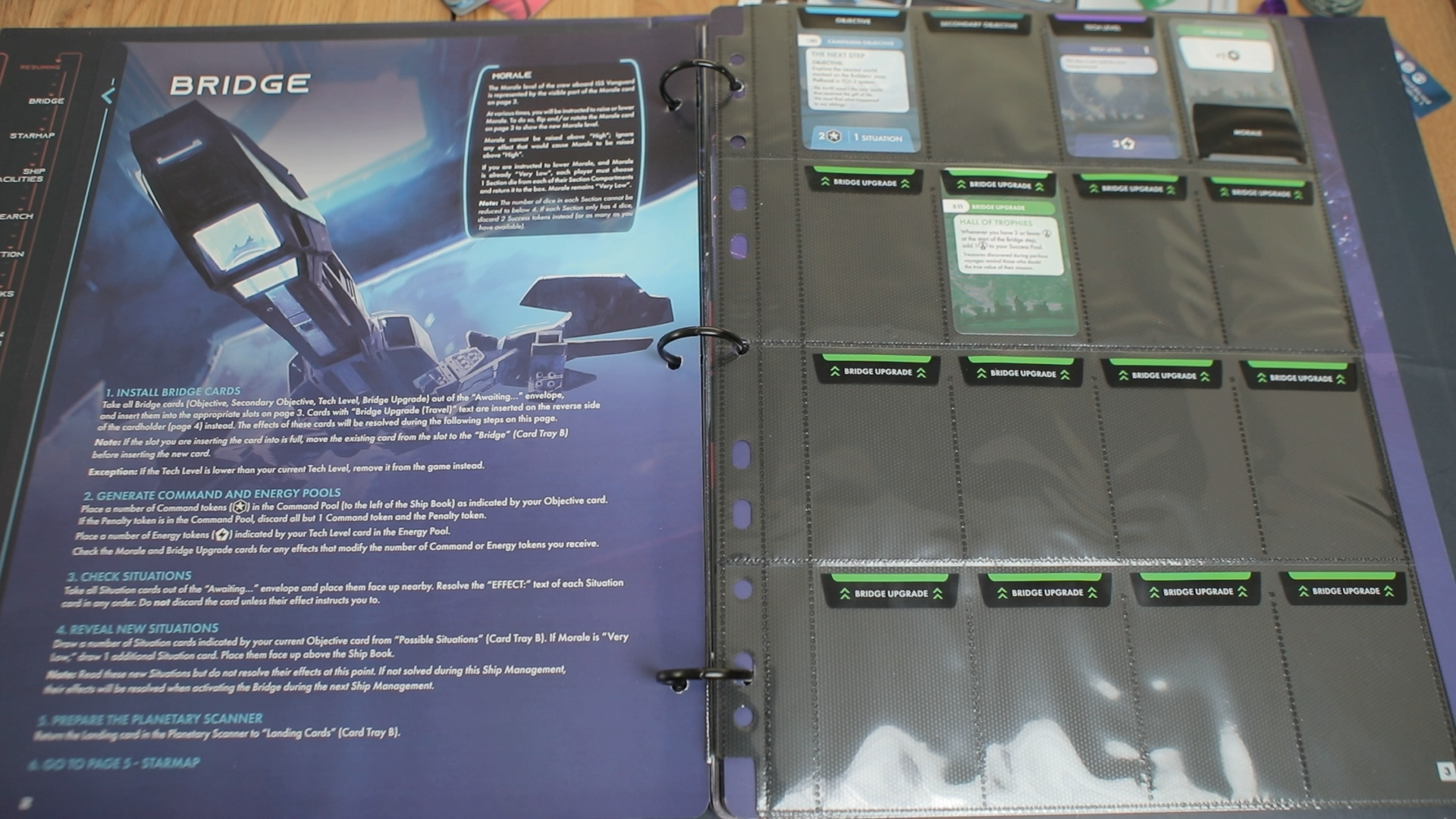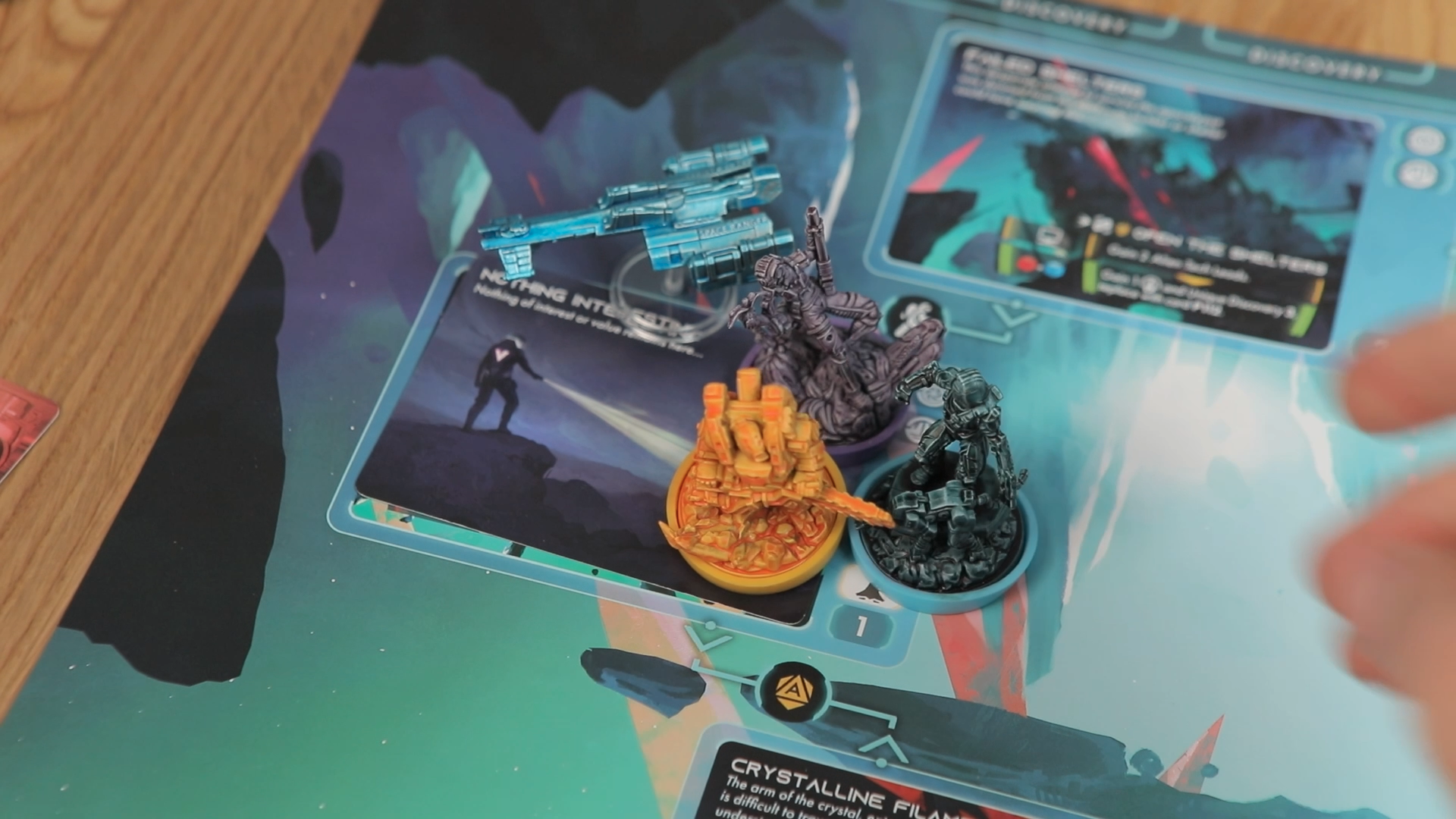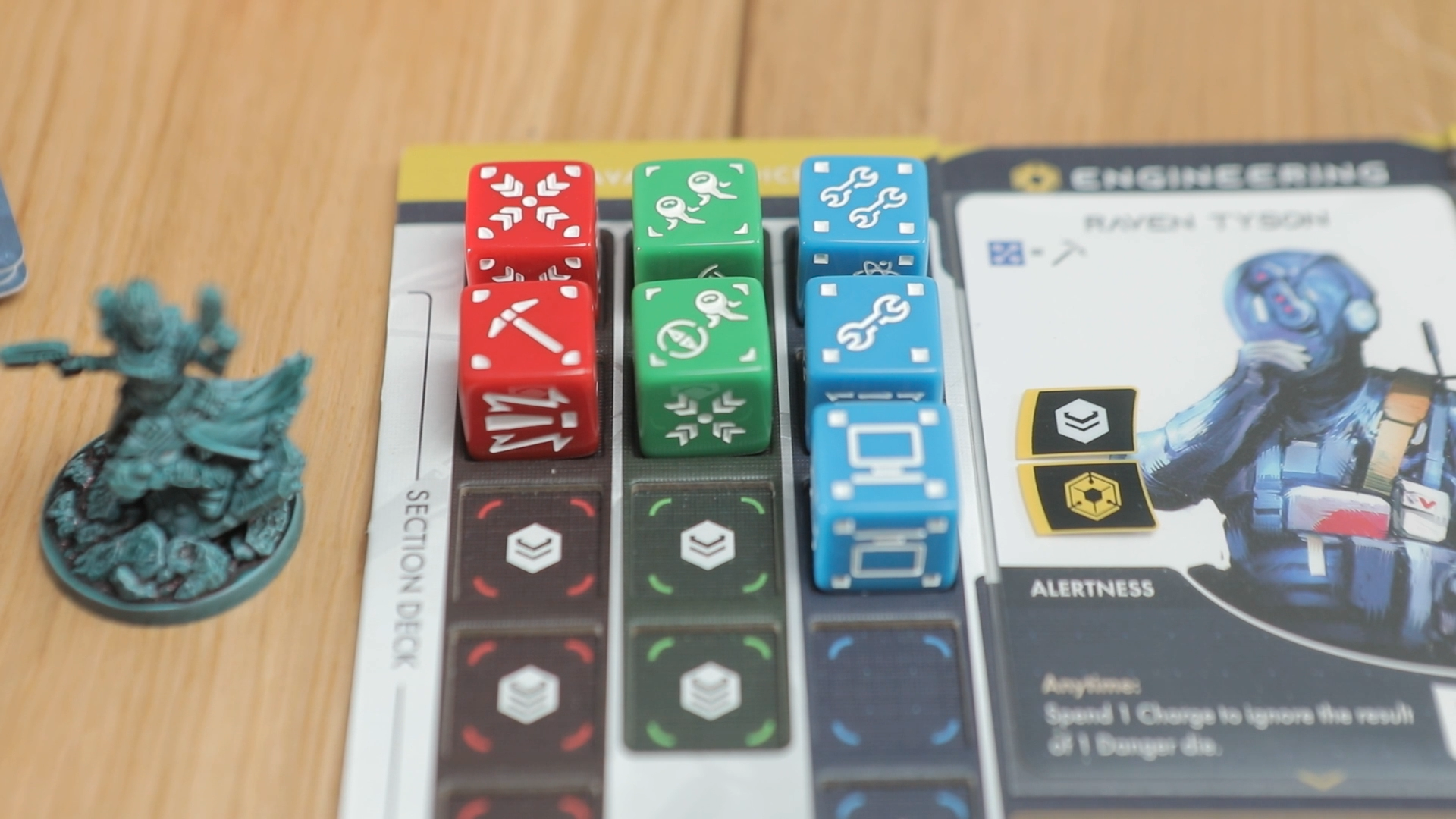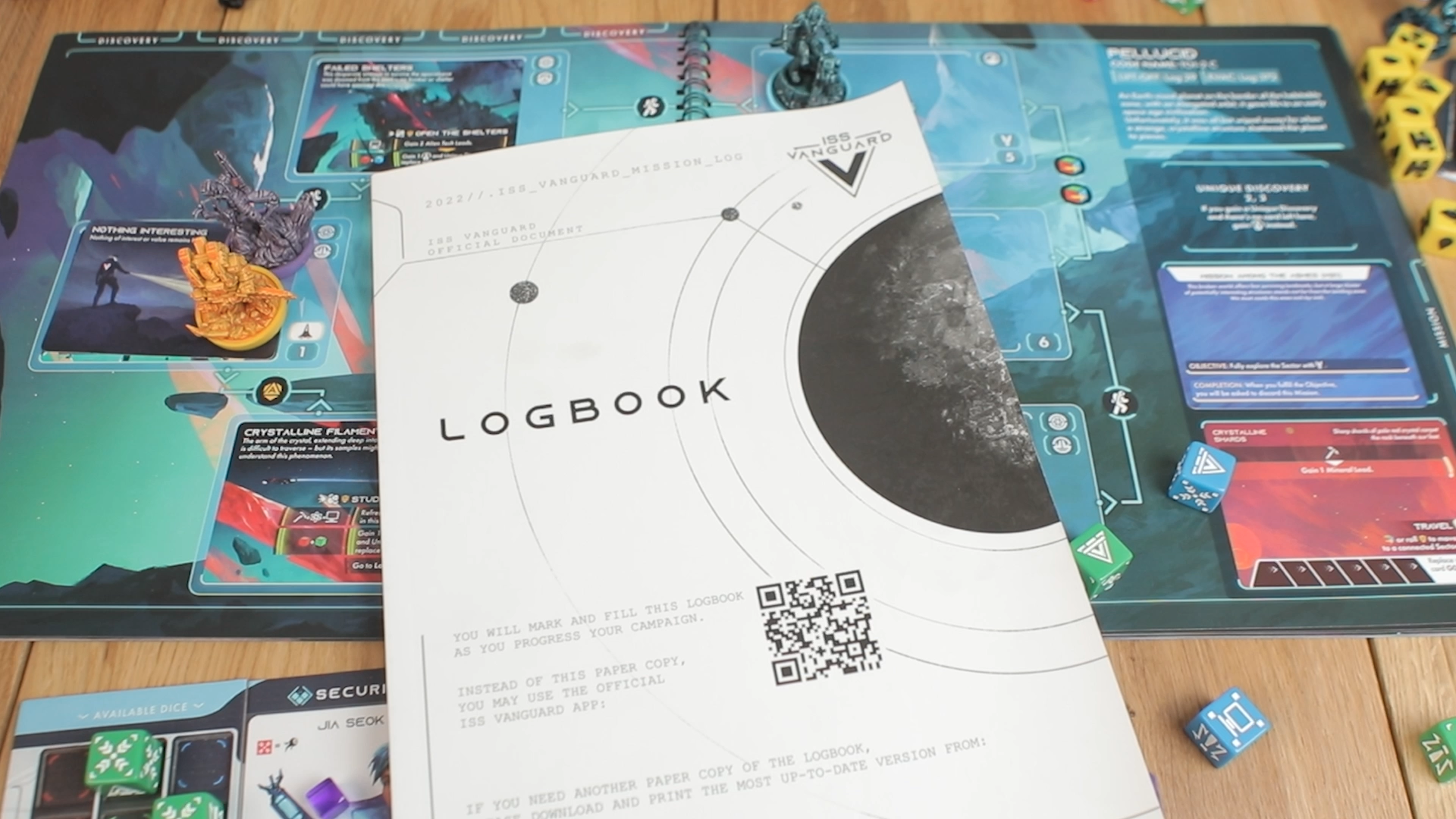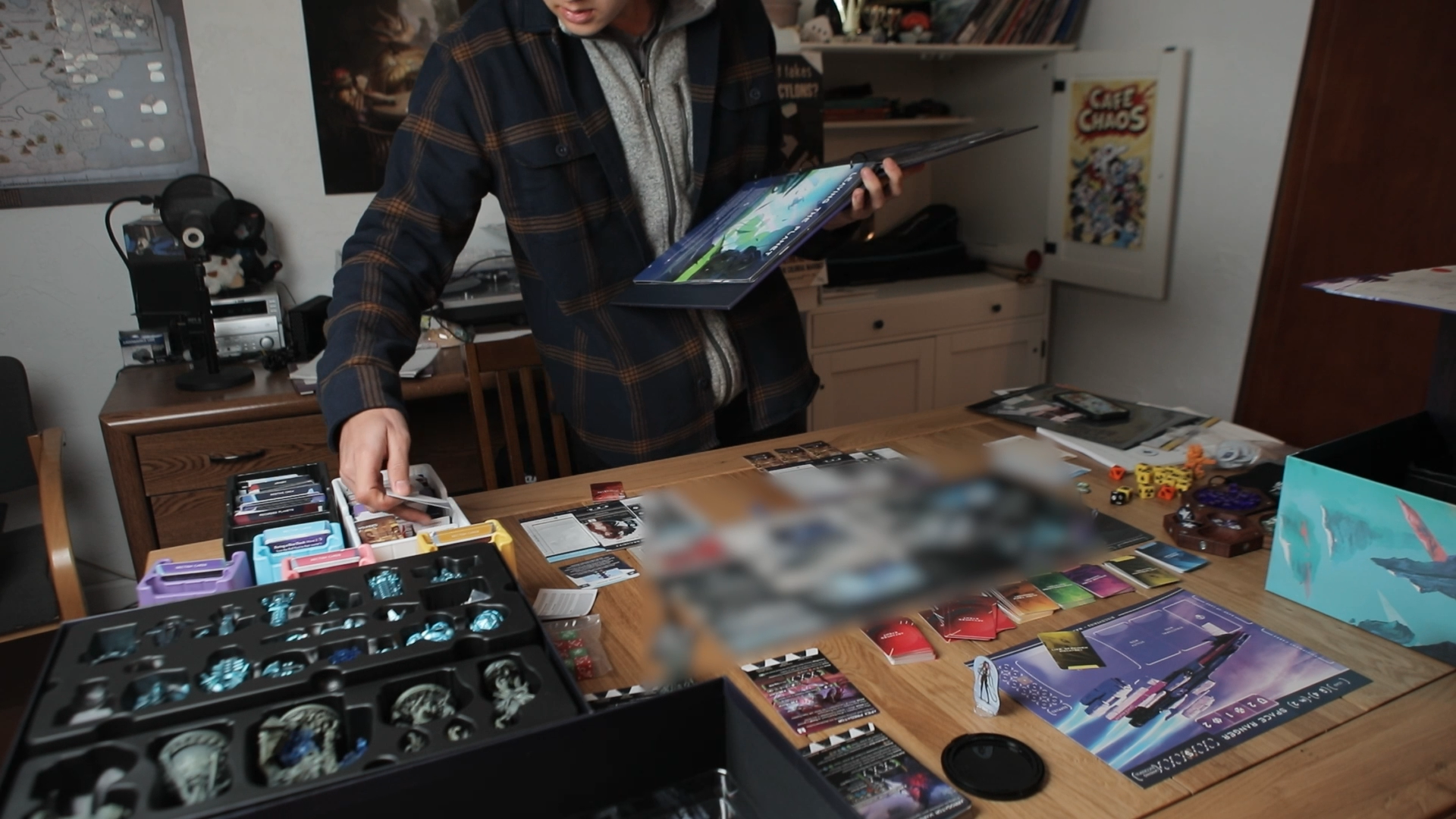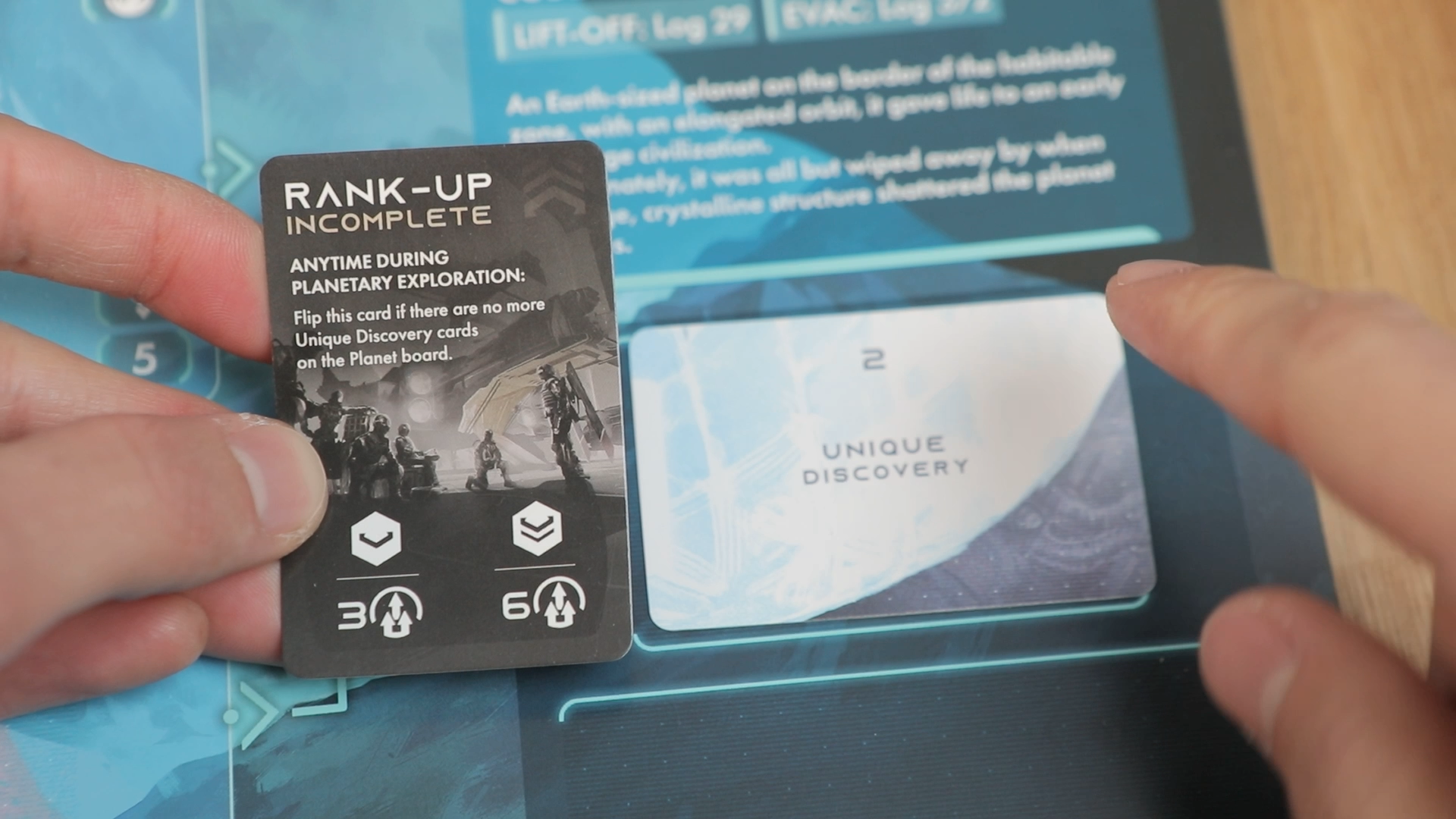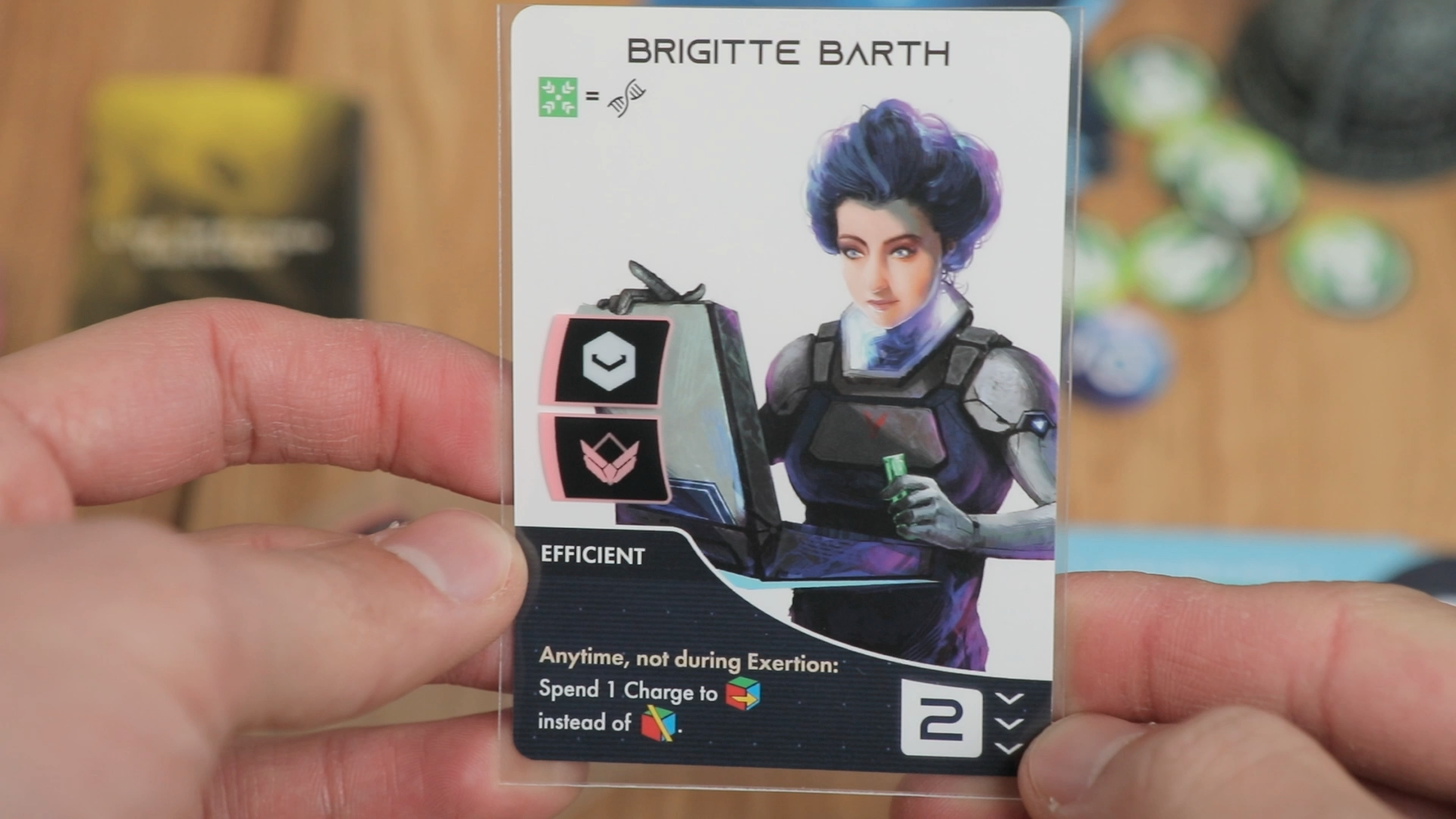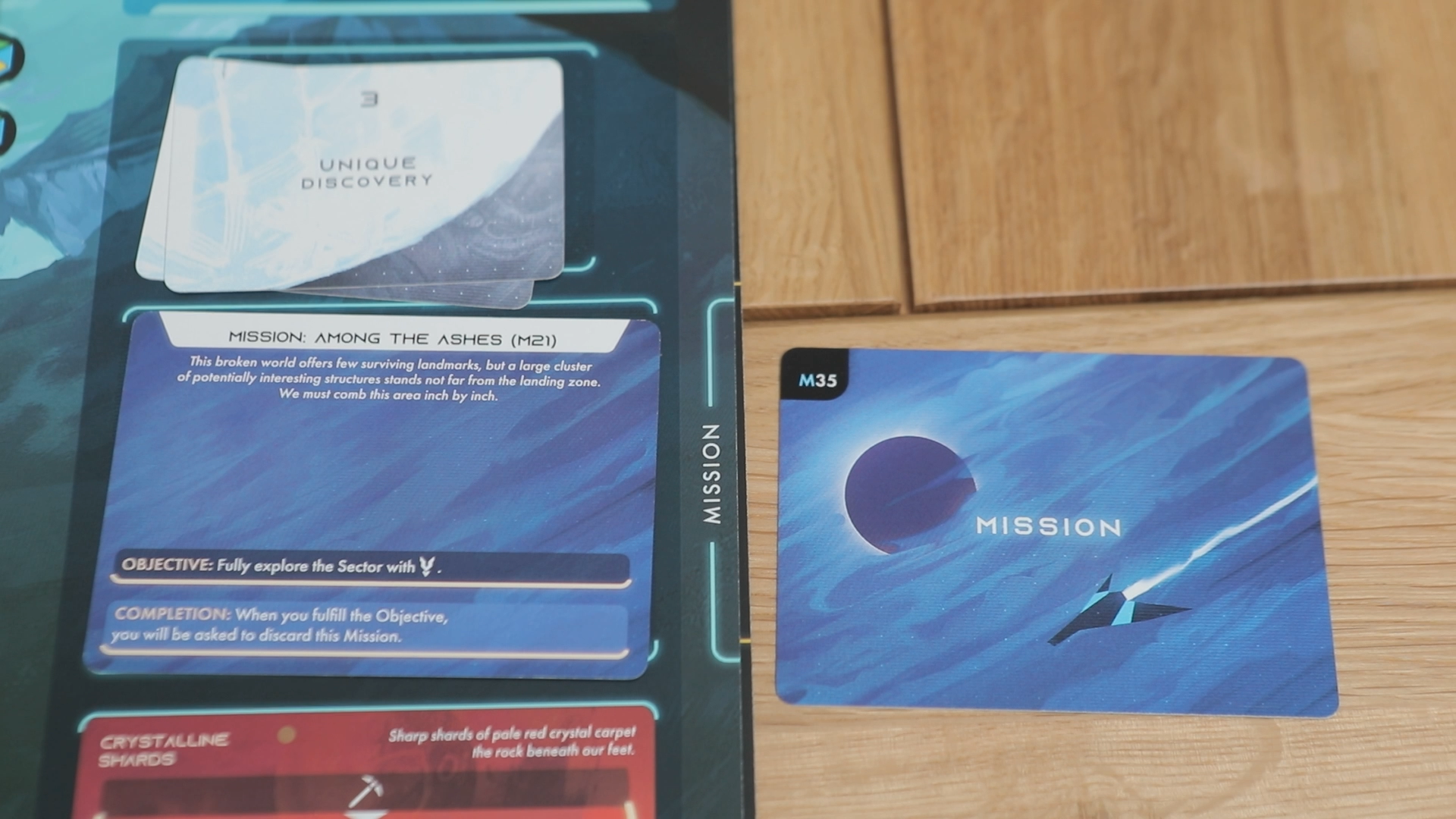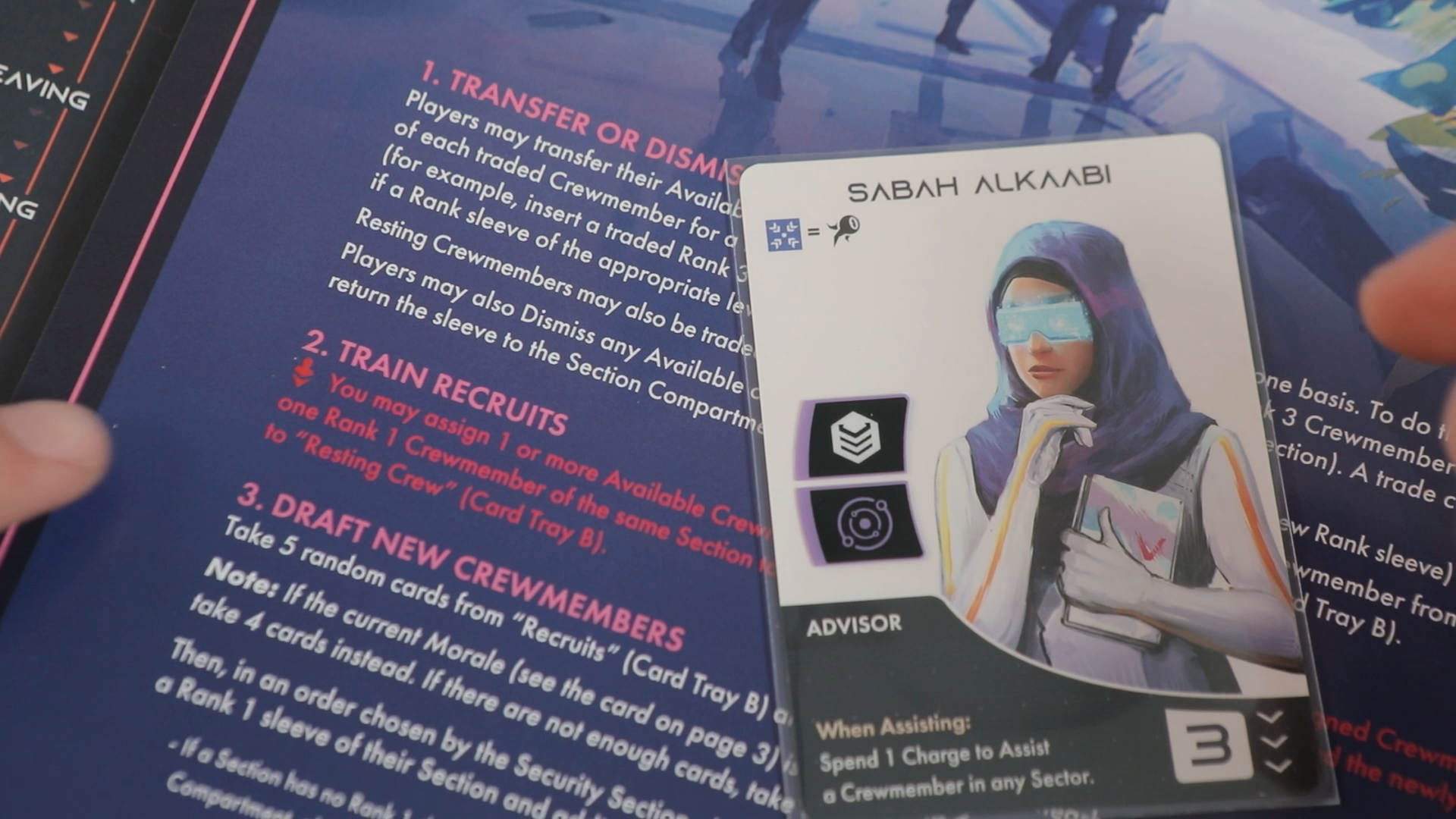ISS Vanguard Review
Find out what lays beyond Earth, epically.
Command a giant space ship, traveling throughout solar systems, with a blend of ship management and planetary exploration. This campaign game features dice and card management while facing exploratory logs while on each planet. Then managing ISS Vanguard itself through a literal binder full of cards. ISS Vanguard takes about 90-240 minutes per session, for 1-4 players, at a campaign that lasts about 20-60 hours. This review is comprehensive, but contains no spoilers that would affect the enjoyment of a campaign.
Video published January 3rd, 2023

Open your ship binder, and manage the multiple areas of ISS Vanguard, by slotting cards in and out of pages.
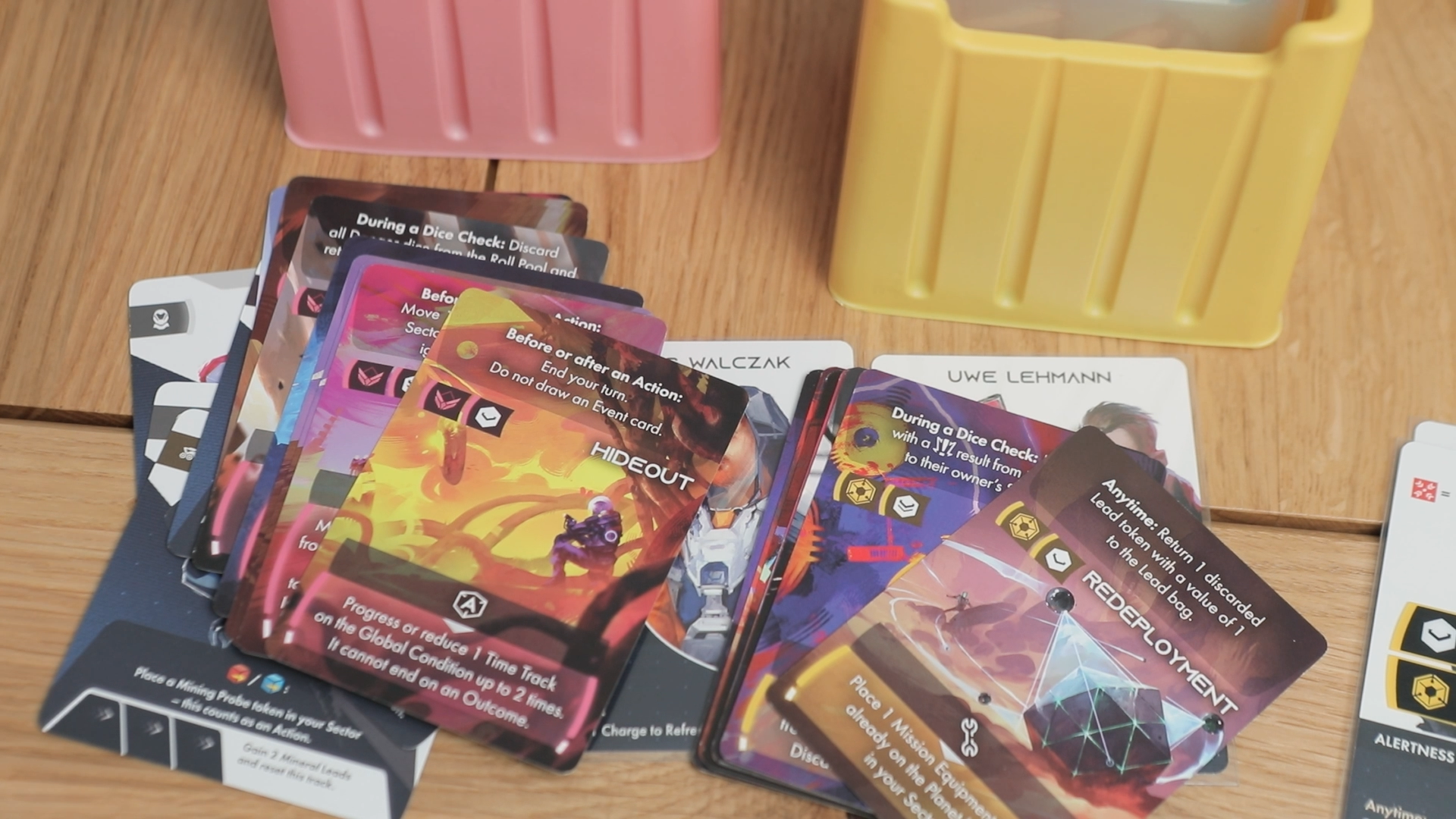
Pick what explorers for each section, as well as cards… and equipment… and your lander… and its modifications!

The meat of the campaign is traveling throughout a new planet, triggering different log reads, harvesting discoveries, and dealing with threats.
Overview
Are we alone in the universe? What lays beyond Earth?
Well, we’re about to find out, as we hop on board the ISS Vanguard for a campaign throughout the stars!
ISS Vanguard itself is a giant ship that was one day built from crazy alien technology that crashed into Earth. Naturally, the big question is, we should find out who sent this alien technology to us?
Plus, scientists found that human DNA contained something dubbed the “Divine Coordinates”, giving us a map to somewhere the galaxy! People from all across our Earth packed into this ISS Vanguard, searching for answers, and our journey starts as the crew is just about to reach the ‘divine coordinates.’ Well, stuff is not exactly as it seems, requiring further exploration of the universe, in an experience made up of 2 main parts!
How to Play
ISS Vanguard is two parts: the exploring of a planet, where you move miniatures around a map, use the game’s 3 colored dice system, encounter bad guys, blah blah it’s the meat of the game. The second half is the ISS Vanguard itself, where you open a literal binder of cards, to manage the ship!
Let’s actually start with this ship phase, where within its pages of cards, it houses your ship’s upgrades, objectives, and looming negative situations. Then you’ll pick a system to fly to, using energy that your ship generates for every ship phase. You’ll eventually pick a planet to land on, but you don’t go there yet, rather, you can do even more management if your ship: from researching cool new technologies, advancing production projects, recruiting new crew members as cannon fodder… pretty basic colossal Sci-fi ship stuff. Once you’re done with this, then you pick a sweet ride called a lander to go to your planet, deck it out with mods, pick what crew members you want to actually perform the exploration, grab equipment that might be useful… and strap in!
Strap in indeed, because often there will be some turbulence in the logs as you try to land, and your lander attributes will come into play as your crew attempts to bring your lander to the planet’s surface as you roll dice and see what happens- sometimes people will get hurt, or you’ll lose equipment. But finally, you’ll be on the planet surface!
This is the “planetary exploration”, as your group lands on a planet from your lander, where you’ll be assigned a new mission- like maybe exploring some certain area. On the way to that, there will be sectors you’ll need to explore completely to continue moving across the map, weather to worry about, and sometimes threats moving around. Every turn, each crew member aka player will get 2 actions, where they can move, draw cards, or spend their action to do the crucial dice check.
This dice check is the core of the game, where areas will just tell you: oh, time to roll a bunch of dice, and you’ll see what icons OR quantity of dice you need to hit. You can pick as many dice as you want, then roll them! You can use cards from your hand to modify the results too. Yellow outcomes are called “partial” results that can give you something extra, but be careful about always trying to get these, since they’ll take away results from hitting the green. You also want to be careful of hitting the red, failed result on rolls, since that do all sorts of bad stuff, like making you roll a danger die which can cause injuries! When you hit the green, either immediately or by moving up a success marker to the end, tons of things can happen. Sometimes it’ll be replacing the card, giving you leads that you’ll draw out of a bag to put on decks, to eventually get precious material for your ship, and the fun output is reading a log; where you open up this Log book, go to the proper number, and read what happens. Oh, and you’re constantly gonna read this log booklet for tons of other things in the game.
Once you finish any type of dice check, all of the dice you use go to your discard. There’s also plenty of ways to make your explorers just spend dice outside of dice checks, like taking an action to move on some paths.
As an action its pretty important to ‘rest’ too, to recover half of your dice and draw a card… but doing so reduces your supplies, so you can’t stay on the planet forever. Also at the end of each of your turns, you’ll draw an event card that will USUALLY do something bad depending on the location you are, so even more reason to hurry! Once you’ve completed your mission, you can choose to keep exploring, or you can get back to the lander and call it a day.
If you don’t complete your mission and you still wanna or have to evacuate the planet, you get MISSION FAILED… some negative stuff may happen, but you can usually repeat the mission, you’ll get em next time.
And we gotta bring up injuries, where you can get them from the initial planet landing, or tons of other ways like failing checks or getting attacked, and each also gives you a yellow dice to roll every time you perform a skill check, and if you match a die to the injury card, something bad happens. If you were to get 4 injuries… you might die… and that fails your mission.
Also also, if you’re in the same area as a teammate when they perform a dice check, you can assist them, meaning that you can roll one die, but also use cards from your hand to modify the results!
That’s the barebones of this gigantic campaign game. Most of the time, you’re on planet, and you do 2 actions on turn, then draw an event, repeat until you succeed your mission or fail it. Not all the explorations are quite like this, the gameplay loop can change… but who knows what will happen as you go into the unknown flying across space?
Pros
Quick notice: we have the Sundropped Version of ISS Vanguard, with the Close Encounters box, for minis just spattered across everywhere in this game. Not only do miniatures for Threats or Equipment look fantastic, but also for crewmembers and the Landers you’ll fly to planets! It’s no doubt that ISS Vanguard is just a gorgeous looking game, with vivid art on all the planets, sectors you’ll explore, areas on the ship, and even the cards you’ll have in your hand. The dice you’ll constantly manage are engraved, going into the indented areas of player’s boards which is sweet. And there’s even a plastic holder to house each section’s (color’s) die when you’re not using them, as well as all of their cards, with dividers!
ISS Vanguard has even more organization, with the 2 main card trays that house most of the cards being filled with different sections and big dividers, keeping a game as big as this fairly easy to setup and take down. From the Ship Book (binder) to the purple transulescent cubes, to the misceaallenous tokens you’ll use, all the components in this game feel premium.
Since I can’t shut up about art, there’s 86 different crewmembers that you can recruit and play as, with each of their own nice portrait AND backstory. This can really get you into the game.
Some more miscellaneous appearance pros are the clear symbology throughout the game, like the biomes you’ll stand on, that are all clearly defined at the back of the rulebook. And the game comes with a tutorial, with separate decks! So you can start playing ISS Vanguard pretty quickly after setting up the initial card trays and not having to read the rulebook.
For gameplay pros, let’s start with the meat of the game, the planetary exploration, which gives a great sense of exploration while also being paired with decision making in dice, cards, and special abilities of planets OR characters you’re using.
The dice check system is far from braindead, where you’re performing a check on the card. There’s tons of agency on choosing WHICH dice you commit, and which symbols of each dice, as every die, even for the same color, can be different. There’s a big sense of ‘pushing your luck’ as you commit more dice to a check to try to succeed, especially since there’s the ‘Wild’ Vanguard symbol that can give any symbol in the game.
You can choose to go for the Yellow Outcomes and be greedy, or just be concerned about the failed outcomes, which can trigger from even rolling certain symbols! Sometimes you DON’T want to include too many dice that could backfire on you for multiples of failed results. Or some of these checks make you roll a danger die during the roll, so that adds urgency to complete the check NOW so you don’t have to keep subjecting your explorer to danger.
There’s dice manipulation abound too, where every character abilities can always transform basic symbols into their specialty, or cards in hand will give re-rolls or crazy benefits if you want to spend a die for something outside of the check. Once you start throwing in equipment, you can get more conversions, or one time uses of a bunch of symbols added to a check!
The way you recover dice is well nuanced too, where sometimes you’ll want to rest in certain relaxing sectors to get a benefit, or do the crucial ‘exert’ action to delete a die for the rest of that session, and instantaneously get back 5 dice, no action required! This is a really cool dance between losing out on long-term strength with less dice, with getting tons of tempo NOW.
Add that to the possibility to get back dice through playing cards in your hand, by rolling certain icons on any check and playing that card, and you have your hands full of ways to recover dice, and how to spend dice to ensure you don’t run out of dice before you can efficiently recover them.
Last pro for this dice check system: injuries! The injury die is so good at adding tension, as it’s a permanent addition to every check to have consequences of sometimes losing dice when exhausted (name of an injury), or giving you more wounds from being severely wounded (name of another injury). After getting injuries, you may want to do less checks with that character, and have them play a support role? If you don’t want to, there’s plenty of cards to take care of injuries too.
The card system, with top and bottom abilities for more options for each card, deserves some spotlight too. Cards are tied to the dice well, where you usually don’t want one without the other, as cards can give re-rolls to not waste dice, or can even recover dice. However, you usually can’t do diddly squat without having at least some dice to spend. You get more out of everyone’s cards by assisting each other on the map too, giving more incentive to assist and group together, and discuss what the heck you all have in your hands.
The cards also have a huge added bonus of essentially granting extra actions, where you can just decide to roll dice on your turn as an action, to try to match symbols on your cards, so that opens up a lot more push and pull: you can spend dice to also spend cards, so you can recover other colors of dice. Or spend dice and cards to draw 3 cards. See how these are all tied into each other? Then of course you have some crazy good other actions to do. How about debating how many times you should use this Rank 3 card before sacrificing it for the bottom ability?
Add this all to how you get to CHOOSE what 10 cards you wanna bring to each exploration, and there’s pretty thoughtful card play about predicting what cards you’ll draw, and learning what types of cards suit your varied characters and types of planet conditions. You’ll learn how the different colors, or sections of the ship, start to differ, with some nice emergent asymmetry. Between security’s injury mitigation, engineering’s focus on equipment, Recon’s focus on manipulating time, and Science’s focus on harvesting leads, you’ll see what combinations of sections work together for missions, as you’ll get to choose which color for each session (if playing less than 4 players). And then each section has their own equipment! (Next paragraph with have very minor spoilers on early Equipment unlocks).
Equipment gives you so much variance, with Stimulants to inject yourself, Live Streaming rigs to call your other crew members, or even drones to automatically mine minerals for you! Them being color-coded means that maybe you DO pick Recon to come with you to provide their exclusive Zipline for everyone to speed around the map for efficient movement. Or the Security team can protect us from a scary monster with their Defense System. These are EARLY game unlocks, and there are dozens and dozens of equipment, with something awesome for every section, including neutrally aligned equipment you’ll want to at least consider for every section to bring each mission.
Planetary exploration also has great opportunities to work together, as you use each other’s equipment, like eating each other’s medicine, and then there’s the useful ‘assist’ mechanic to make any check VERY efficient to do with a teammate, as the person assisting doesn’t roll injury dice, and can play a card on the combined roll pool. And while there are countless crew member abilities with fun abilities, we’re gonna focus on the ones that encourage cooperation, like a follower who can follow someone else’s movement for free. Or an alpha dude who loves to get assisted and can change their assistance roll into anything.
This all comes together for SO much planning opportunities for each planetary exploration, where you choose which crew members to bring, what gear, what cards, what lander, and what equipment, all based off of either flavor text hints, or clear warnings. Like if you’re planning on doing a grab and go investigation for movement, maybe you’ll take a Jetpack with the Recon team. Even when going back to repeat planets you get to choose this whole load out again.
So those are all of the pros of how the core systems work… but do they actually come together to feel like you’re exploring a planet? And YEP. YES. There is a huge sense of wonder, as right when you decide your team’s load out, anything can start happening to the crew. When trying to land, your lander may not be up to snuff with the new atmospheric conditions, and crew members can suffer injuries before the exploration even starts. Equipment may fall out during the turbulence. There may be other scenario specific stuff involved that I can’t spoil!
When you eventually land on the surface, more of anything can happen, as you read logs, and see all of the planet conditions you’ll face… which could be anything to hinder just movement or give buffs, but maybe only temporarily. There are log prompts to read EVERYWHERE as you may trigger things, giving you a real sense of wonder to go and explore. And there’s even log prompts to read when you fail things… and logs will be directly related to your current task and planet, making them always feel REAL. As you travel around, you can find all sorts of different types of sectors, like some rotting room, some secret underground path, or some story bit will finally be solved with a discovery, or yeah monsters can get angry at you for poking around their homes. Or you can talk to NPCs on spaces!
Even getting discoveries make the planet feel real, where some of them grant immediate benefits, like drinking protein soup to get 2 extra supplies, or discarding another alien plating to add a bunch of alien knowledge to a single roll. Wait, do you want to consume these discoveries now, or haul them back on the ship for the scientists to put them to good use?
There’s even effort poured into having the planets transform over time, as day can go into night, or storms come up, or some other crazy weather thing I can’t spoil. Basically, don’t take too long… or maybe you sometimes want to wait for more favorable weather. Revealed threats, AKA sometimes monsters, are also nuanced and fun to play around. Each of them have their own way of resolving and moving around the board with abilities and a specific time track. Very minor spoilers here, where some will be straight up hunters gunning for your crew members all the time, while others are peaceful… at least at a glance. Every time you see a new type of threat, its up to you to think about how hostile it is, whether you can kill it or not, and what the rewards might be for killing… because when you ‘think’ you’ve killed a monster, you read a log and see what happens…
The game just doesn’t let up on the tension with its ticking time, because at the end of every player’s turn, you flip an event card, which does something, except when it doesn’t match your sector’s biomes, like if you’re in a desert when it asks for a cave… which then it advances ALL time trackers! Yep, this can change global conditions to unknown stuff, sectors slowly fade away, or you window to complete your mission is getting smaller. Or a monster gets progressed to attack your team with its unique ability! It’s a feeling of real uncertainty when you have a BUNCH of these time trackers, and you have to draw an event, and you’re super tense about what can happen if it moves that time tracker.. because a lot can go wrong!
Exploration ends up giving a TON of things to do aside from the main missions, with sometimes optional missions, unique discoveries to grab, or maybe you just go greedy and try to maximize the quantity of normal discoveries! There’s also a little mini-game of getting to ‘rank-up’ your current crewmembers by accomplishing a task… which isn’t perfectly executed, but definitely something you can play towards. It’s really up to your crew to decide how ambitious you want to be in accomplishing all that’s there on the planet before you run out of time. Exploration never really drags because of this, as you have so many things to explore and accomplish, but also so much working against your ‘away team’.
The last pro for the planetary exploration phase of the game is that its gameplay meets the theme well. You’re a specialized crew with a bunch of planned high level equipment that can be lost at any time, departing your lander and then faced with a ton of unforeseen issues. You endure planet conditions and persistent threats to trek across the planet, all the while sometimes exerting yourself often facing exhaustion if not careful.
Like, the injury mechanic really comes together in getting freaked out by a alien threat attacking you, then getting panicked, then your character starts constantly second-guessing themself on every roll afterwards, having to re-roll their wild results, and sometimes just throwing away supplies. Or your backs are against the wall, and you’re constantly eating nutrients and injecting yourself with stimulants to get the last energy you need to escape the planet.
Pros 2
How’s the campaign with the overarching story? The story is pretty good! In your quest to find what happened to the events after the opening comic, there’s gonna be plenty of twists and turns, involving different NPCs in the ship, different life forms you’ll find, and of course, some interesting decisions for what the ISS Vanguard should do when faced with dialogue, scientific, or even moral questions.
So reminder here: I ALMOST played through the entire game, went 17 sessions in, so I got to what I’m deducing to be anywhere between the 5th, to 3rd to last scenario. BUT I went through the entire log booklet all the way through to speak about the story for this review, and it is worth going through in its entirety and doesn’t have anything jarring. Like, if you’re into Sci-fi, its definitely par for the course, and there’s plenty of pretty realistic nods at the way technology and culture affect things.
I can’t really say more than that without spoiling it, but what I can say is that the way the story is told, aka the narrative is well done.
We already discussed how thematic and varied the planetary exploration is, so let’s talk about the Awaken Realms speciality: the giant log book with almost 1000 entries. These play off each other in the classic Awaken Realms way of referencing each other with checking off boxes, and having decisions carry through the entire game. Since we’re on a ship with a ton of people, you’re gonna witness all sorts of text, from AI speech, the away team talking, the captain talking, scientist’s journals, or even top secret data entries. This again gives a great sense of scale to tons of viewpoints on an overarching story that makes the story feel big and real.
And you know how I discussed how each planetary exploration is tense? Well, the awesome thing about ISS Vanguard is that you can usually go back and explore planets at any time, meaning that you can handle the game at your own pace. If you want to be a completionist and do everything, you totally can for tons of cool unlocks, and the game will reward you with nice upgrades as you bring back a lot of trophies to the Vanguard. There’s TONS of hours of gameplay here in unlocking everything, if you want to.
Let’s talk about the presentation of the ship phase, because that is also doing a pretty cool job at telling the story of the entirety of the population of the ISS Vanguard progressing. There’s people with jobs on board that aren’t just the away team, so there’s groups researching new technologies for you, or building more production projects like new landers for your planetary exploration to use! Or they can come up with new equipment for you to start using! Even the ship itself will get stronger! It’s not all fun and games though, because there will be Situations you will have to spend effort to dissolve, like people starting to worship weird stuff, maybe there’s some mutinous thoughts, or maybe you just have the crew play ‘Intersectional Games’ against each other to raise morale, which affects future Ship management.
The upgrade loop will go like: your awaiting folder will get TONS of cards as you encounter things on planet… and then when you’re back on the ship, you take those cards out… which can lead to getting even MORE cards for your awaiting folder! All these cards means fresh new possibilities that are just around the corner, giving TONS of incentive to keep playing the game and play with all the new things.
The campaign story’s overall pacing is also pretty well done. There’s constantly logs that are dropping hints about the main arc, whether or not you’re actively pursuing the main mission. Plus, there’s not much filler here, and you can ‘skip’ less important systems if you really want to.
The hidden envelope and “campaign progress” page unlocks are also really well done, so definitely an exciting unlock and handle the progression in a cool way.
I wanna add that doing research projects is incredibly forgiving to give the campaign a great sense of smooth progression, because when they’re gonna ask for specific discoveries a lot of the time. But then a lot of discoveries can be discarded when you get them to draw another discovery, so you’ll rarely find that you’re held back by just ONE discovery, which would otherwise mean having to go back to a planet to spend at least 30 minutes to get one thing.
Last little bit of progression we haven’t mentioned yet is getting recruiting more crewmembers to use! This process in itself is fun in its flexibility, where you get to CHOOSE which color sleeve they go to— so what type of section a person gets allocated to, regardless of their ability, so that means there’s a fun mini-game there in seeing where there might be deficiencies in your ranks and filling them. All the crewmembers also have a tangible use on the ship to feel like real people at your command, where you can use them to boost, or speed up progress on areas of the ship, using them for tempo there while forgoing a chance for them to do the next planetary exploration and rank-up.
All managing your available crewmembers isn’t just limited to the ship phase, where sometimes you’ll get a chance for them to interact with other phases of the game, which felt INCREDIBLY fitting and handled the increase of quantity/quality of members well, but again, I can’t go into that because spoilers.
Then, the whole game runs really true to time overall! I mean, ignore the Gamefound claim of the playtime being 90 minutes, rather go by the rulebook saying that the tutorial taking 3-4 hours, and then each session taking 2-4 hours. The entirety of the campaign really is about 20-60 hours like the box says, but the 20 hours is probably only possible on repeat plays. If you’re playing with multiplayer, yeah, expect each session to take at least 3-4 hours and for the campaign to be well north of 50 hours.
Our very last pro, to wrap this entire huge list up… is actually the app! There’s a free App to use, and was the main way I chose to play the campaign, and it is really nice to automatically keep track of your progress. It really comes together with the audio cues, that work exceptionally well to hear sci-fi sound effects, like radio transmissions, and the snippets of dialogue of crew members talking to each other. If you’re playing multiplayer and reading text aloud, this is especially useful to have the app change the voices for you.
Cons
For all of our praise on the rulebook and tutorial, there are some places that feel pretty lacking. Like how the tutorial just unceremoniously throws you into the first Ship Phase, which doesn’t have diagrams to explain anything, especially on a macro level. When you go to the rulebook for clarification on Ship management, all it does is tell you to refer back to the ship binder, which only tells you what to do for each page.
Now its still awesome that the game had a tutorial, but there really seems to be a huge missed opportunity here, to either add more to the tutorial in covering the ship book, or more of the rulebook under ‘campaign rules’. Luckily, the game is correct, anything you do in the ship binder for the first phase of the game cannot really hurt you, and it gives you some nice tips.
Then, throughout your journey, there is going to be COUNTLESS little weird questions that come up… with different items, character abilities, and campaign interactions, and there’s no FAQ at all in the rulebook. There is a giant unofficial FAQ on BGG that helped immensely throughout my campaign, so why isn’t that included in the main game? Its super frustrating to have to look through the index of the book, find the thing, then find out its not clarified, and then have to go to your web browser. There’s also an official PDF from Awaken Realms which is less in depth but still very useful. One thing that I couldn’t find the answer for was: What happens when the time tracker gets to the end of a track and you don’t resolve that space with this guy’s ability. Does it ever reset, or did we break the threat system?
Plus, when you’re first starting out in the game, you’ll also be asked to set up the card trays following instructions in the rulebook. My advice is to not actually follow this exactly, where it tells you to put the cards behind the divider… actually putting it in front of the divider makes a lot more sense to grabs cards easier. Also they should have clarified that this ‘planet’ divider card goes nowhere at first, because I thought I lost my mind not seeing it in the rulebook for the longest time…
As for components, the Gravitational Fortress card was missing a standee or miniature. And the danger die symbols are EXTREMELY tiny during planetary exploration, especially on threats, to make you feel like you’re reading medicine labels while doing climatic danger checks.
When you’re actually moving around each planet, stuff starts to get quite cramped too with all of the awesome, but still unfortunately obstructing minis. The sector cards just aren’t big enough to have all of their stuff with minis also on top of it comfortably. Plus the sector cards just EASILY move around due to how you’re constantly moving stuff around on the sector, which means you can accidentally overlap EVEN more stuff that’s printed on the board. Now all of this mini blockage is just hard to fix, because if you made the cards bigger, you would have to make the planetopedia bigger… but then its already so big! Maybe two booklets like Jaws of the lion would be a decent compromise?
The writing does have bumps now and then too, for when it talks in the PAST tense, even though you’re currently in a mission, which is very jarring. What mechanically hurts, is that how it will sometimes, in the later parts of the game, have a bunch of flavor text, then end without any other info, especially if you’re talking to an NPC.
Does this mean you have to back to what you were doing before, or can you freely return to the previous log where you could ask them questions? We’re assuming your action just ends, but would have liked to see the words “return to planetary exploration” like the game sometimes does, more clearly plastered on logs that happen during that phase of the game.
Then please go through the ‘known issues’ in writing across the game and fix them before you play to minimize confusion, in the PDF shown to the side. Maybe even more reason to use the app?
But then the app has problems too! It’s good enough to use as said in the pros, but there’s a ton of things holding it back that make it a very frustrating experience to use. You CANNOT go back and look at logs you previously done! Like what the heck, this is extremely annoying. And you don’t want to just punch in the log number again, because since the app is kinda discrete whether or not its checking off boxes, you don’t want to trigger an accidentally box check, so you end up using the physical log booklet for that one log. You can’t permanently revert to using the log booklet though, because all your progress is saved on the app!
You are locked in with using the app once you do it, but often you have to dual-wield the app and the actual log booklet when confusion comes up. Sometimes you even want to have the log booklet on hand for when it’s checking off multiple boxes, as that can be an incredible hint to return.
Now we get to the gameplay cons, where we MUST warn about ISS Vanguard’s annoying scaling problem: the more sections you play with, which is probably more people, the more reasonable the campaign is to finish. This is because having more crewmembers means getting tons of perks from assisting each other with a bigger pool of section cards, dice, and character abilities to select for checks from. With less characters, sometimes you’ll be knee deep in an exploration, and you’ll realize that you just don’t have much left of the correct dice for one very specific check that come up later in the mission (you’ll have to delete dice very often), so you have to just cross your fingers and hope to roll wilds.
Planetary exploration is all about going into the unknown, so even if you think you spec perfectly based off the landing card info, missions can take a turn and throw all sorts of new stuff at you, especially when the game gets harder. Just having more dudes at the ready can only help, and taking time to move each traveller isn’t as punishing as it might seem as the certain missions have certain log prompts.
It’s a BIG hint to do this, when hard missions say: “hey, you should really think about bringing all 4 of your sections to this”. Also having 4 crewmembers means that if your group ranks up, everyone gets the rank up! So it’s like your crew can rank up twice as fast with 4 sections as opposed to 2.
Oh hey, the next gameplay con is this ranking up system, where you draw 2 right before planetary exploration, and pick 1 to try to accomplish.
So ranking up your characters ask for some pretty specific things to do by the time you end your mission, ranging from very do-able to sometimes actually impossible. Especially when paired with having to get success tokens. This is gone into in more detail in the video review, but basically we suggest drawing 3 rank up cards before each mission and then choosing 1. Or how the one that involves a threat should just be entirely reworked.
Then you might ask, why are you being so concerned about rank-ups? There’s only 3 ranks, and having rank 3 is permanent… right? Well, kind of, because characters can die permanently in the game. This matters more in the later parts of the campaign, where missions start getting hard. So there’s 2 main ways for characters to die, one is if they get 3 injuries then have a CHANCE of dying after the scenario, and the other is if some event happens in the campaign and/or current mission to kill them off. The latter can be practically unavoidable at times, but the game can give you some warnings if you’re not too deep in trouble yet. Losing characters hurts on an emotional level, which is actually pretty cool, as you see the homie you’ve gone with to different planets pass away tragically. But is also hurts on a gameplay level, because if you lose a rank 2, or god forbid, a rank 3 person, you now REGRESS back to a green rank 1 if you don’t have any substitutes in your waiting crewmembers.
This just feels bad, as maybe you won’t have access to the same amount of dice you spent so long to unlock for your high ranking characters, or worst of all, not getting you access to all the sweet rank 2 and rank 3 cards. Your deckbuilding possibilities get slashed to just 14 cards for a deck of 10, with more generic options for rank 1, instead of the 20+ with the strong asymmetric unlocks. It’s the game ‘re-locking’ cards as punishment.
Losing a member and having to go back to rank 1 wouldn’t be that bad if you could easily rank up, but you can’t consistently do that as we just addressed, so it can be REALLY crippling in the later missions when your high ranking characters, the ones that you want to bring on hard missions, DIE if you get the WORST option of failing a mission. Then you don’t want to return until you’re really ready, so you have to go back and train certain characters to an equivalent rank, which can add at least 2-3 extra sessions with an unpredictable rank up system, on top of redoing the mission you failed. Did someone say grind?
Will this happen to everyone? Certainly not, because ISS Vanguard is filled with so much game variance, with not only the die rolls and card draws you’ll see on each planet, but also what crewmembers you happened to bring that might sync up perfectly with whatever symbols the hard missions throw at you! Or maybe you’ll happen to get some crazy technology unlock early from a super good discovery card, and that just keeps your game smooth, and you have multiple rank 3 members near end game or something.
Some ways to patch up this current system could be to make rank-ups much easier to do, so you just have more rank 2 and rank 3 members. Or if you lose Rank 3 members, having a possibility to pay to promote a current rank 2 member to rank 3, that way removing or reducing the need to grind to beat harder scenarios. After all, in a game filled with dice rolls and punishing outcomes for failing those, its probably better to have luck on your side rather than not.
Nitpicks
You know how we mentioned the deckbuilding, where you get to make your deck for each section before exploring a planet? Well this can start to get a little same-y when you ALWAYS see the same cards over and over again, as there’s only 14 cards for Rank 1, that are in pairs, so really only 7 cards. Now granted, ISS Vanguard is not a dedicated deckbuilding game, but I’m curious if they could have at least sectioned off certain cards to be unlocked as you meet game goals.
This really stuck out, because there’s SOOO many lander mods and equipment you keep getting throughout the game, but you NEVER have quite that same magic of getting mysterious new cards in your hand! Sure, this would require more plastic baggies to block off cards, so we can see why they didn’t do it, but hey, there’s a reason why getting new stuff in Gloomhaven: Jaws of the Lion for characters is so satisfying, even just new 1 card can go a long way.
Next nitpick is the ship book’s facilities page, aka the main area where you do decisions with the ship binder. So it actually doesn’t have that much decision making, and really is more like a means to story points or to give you ideas for planetary exploration. It’s not ‘half of the game’ in decisions, for maybe sounding like half of the game during marketing. More info on this in the video review, with how the Research and Production Project pages are just so good to do, but this phase does get spiced up a bit when the campaign check point unlocks.
The streamlined nature of the ship booklet is actually pretty cool to keep each play session short, but then it left me asking, well if there’s not gonna be that much decision making for this, why make it such a convoluted part of the game with so many steps to follow?
Last annoyance with the ship book: not sure why they didn’t make every sheet plastic in here, and them being differently sized is a little annoying to flip back and forth, because you’re CONSTANTLY going forward and backward.
Minor SPOILERS Cons
Last chance to scroll away!
Last chance!
Ok, we’re going in.
So there IS a planetary exploration in the later part of the game that really starts going against ISS Vanguard’s strengths. See, the gameplay loop is best when you have the wonder of exploring and adapting to playing around a new planet, facing new threats and creatively sequenced areas to grant you all these fun vivid exploration moments.
One mission starts subverting all of these things, because it has a puzzle, which is a cool idea, but it unfortunately just doesn’t really make any sense because of how weird and otherworldly it’s trying to be.
-sigh-
I don’t want to spoil more, so a good similar example is Final Fantasy 15, an open world game where the magic comes from hanging out with your buddies on a massive roadtrip in a breathing world, having your buddies jump around next to you for team attacks and say awesome stuff. Then for some of the ending has you just completely isolated from your buddies, and you just walk down a dark corridor, and its not fun and you want it to end. And this is ok for a bit, it really gets the sense of isolation and despair for about 30 minutes.
In ISS Vanguard, crewmembers have each other, but you’re isolated from exploring, in a tedious full-fledged mission that just doesn’t end for at least 1-3 hours! It just subverts a lot of what you’ve come to expect from the game. When planetary exploration fails to give you cool story bits and fun planet personality to play around, because it certainly does for most of the campaign, turns just become 100% dice management for checks again and again. Need I remind you, the puzzle just doesn’t make sense… yes this I where I ended my campaign.
But, I had to read ahead and see what I missed to make this review… and while the missions seem to at least make more sense later on, the difficulty definitely doesn’t let up.
This is a pretty worrying trend for ISS Vanguard’s story related missions, because the game really wanted to ‘make the final missions hard’. But then in the core dice rolling system, that means more dice rolling, and harder dice checks. That translates to sometimes you’ll just sit on the same sector and do dice roll after dice roll, with longer missions and new movement rules to inhibit or discourage travel.
I can really see what they’re going for here- you are on the final missions, taxing your crewmembers to their limit and the normal get-out-of-jail free tricks you used before just won’t do the trick… but when you fail again and again, or ultimately lose to have crewmembers permanently die to regress the game, it sucks!
This system CAN work if you get good luck on the final missions, or just happen to have the exactly right team and equipment, and it also helps if you play with all 4 sections like we said earlier in the cons. But even if you’re doing well, these can still start burning you out of the dice rolling. Before, the game was more balanced between the ship management and planetary exploration. If you’ve already sunk at least 20-40 hours on gameplay, then have to dice roll even MORE for the end, is a tough ask. If you’re playing and are already on the fence about your enjoyment about dice rolling, just don’t even bother with the last scenarios.
How could this get fixed? Well, first either make missions that make more sense, OR if it does want to be weird and otherworldly, reduce the amount of dead ends. Then, the game could make the campaign overall just shorter so players wouldn’t be as easily burned out of dice rolling, and/or lean on the side of making checks and log prompts easier.
Let’s talk a little about the story… in pretty much a cautionary nitpick. From what I’ve seen, the story is surprisingly linear (still about 2-5 endings possible), and doesn’t really give the players a lot of crucial decisions to make throughout the unfolding of events for such a seemingly big world at the game outlook. Like, there’s one crucial decision you need to make which influences some mechanics, but you don’t really hear about it much from a log point of view until much much later, which seems a little empty. If you were expecting Tainted Grail’s more open-ended, NPC laden story, ISS Vanguard doesn’t have as much, while ironically being a game where you an explore anywhere at any time.
Final Thoughts
ISS Vanguard’s gameplay is mostly about trekking across a planet’s surface: finding scientific leads, doing negotiations, or just being thrown into a treacherous planet and seeing what you can do before time runs out. You’re slowly getting weaker as your crew goes deeper and eats more into their supplies, wondering what’s around the next corner. And survival-y story bits will happen all the time, whether it be persistent injuries weighing down people’s checks for a downward spiral, or crewmembers freaking out over the intercoms about some new monster that has unique movement patterns.
The 10 step dice rolling system offers a lot of possibilities when properly grasped, granting countless ways to push your luck or alter the gobs of dice you’ll eventually roll as you keep progressing into the game. It’s not particularly deep, or wants to be, leaning on the side of fast checks, and good thing it goes pretty fast, because there is a lot of dice rolling throughout the campaign.
The journey of the ISS Vanguard comes alive when the ship book phase meets the planetary exploration, to give you tons of story bits and cool gear to play around with. And a TON of events, I mean A TON of events will happen to, in, and around ISS Vanguard which are all worth checking out. The game rewards you for constantly planning ahead, whether it be some efficient route across the universe, or a 15 minute discussion to gear up your 4 man away team with the right decks and mission equipment to succeed.
But when the game ISN’T leaning into as much of the open planet exploration, things can sometimes start to get funky. Some tasks don’t quite make sense, feeling hard for the sake of trying to keep up with the game’s unlocks, leading to an incessant use of dice checks. Couple that with an unhealthy rank-up system, the app not being as good as it could have been, and I’m actually pretty hesitant about recommending the campaign gameplay all the way through.
Yes, the campaign is mostly lenient on how you want to approach it… until its not when the difficulty gets cranked up. It’s a sudden 180 in what might have initially drawn you into enjoying ISS Vanguard’s planetary exploration in the first place. Good news is you’re gonna get TONS of gameplay value by progressing through the majority of the campaign and playing with upgrades, you can add in friends to finish up old planets, and there’s even an Operations Book one-shot scenario that blends exploration, intrigue, and planning well.
It’s a little funny, that I’m recommending a campaign game for you NOT to finish the campaign, but let’s be real, if you’re playing this game multiplayer, are you gonna finish the campaign of over 60-80 hours if you want to take your time and soak in all of the planets, and really think about the log prompts? Maybe? Maybe not, there’s a ton of board games that exist out there? So, if the dice rolling checks seems cool to you in the overarching premise of let’s hop on a ship and go somewhere, ISS Vanguard will not disappoint for the scenarios that MOST people will ever see. The game actually creeps up to an 8/10 Recommender Score if it was only evaluated on the early to mid parts of the campaign.
And the ship binder is NOT a gimmick, though it by itself is not going to get you invested into the game. It is very much appreciated in the scope of this campaign, but that still doesn’t prevent the game from being a HUGE table hog… and the game still has card management galore. You’re constantly taking cards in and out of the card trays, moving cards in and out of your ship binder, and then you still gotta find room for the log booklet, even if you’re playing with the app. If you’re the type who just wants to HURRY UP and play to explore, the ship phase forces you to slow down.
Is ISS Vanguard the campaign experience for you?
Well I again gotta warn again: you GOTTA be ready for the dice rolling and the massive amounts of card moving with the trays throughout the game. That will NEVER change, and even if you like the story, you’re gonna be suffering if this admin is not up your alley over 30-40 hours.
But where ISS Vanguard wins in is flexibility with constantly mixing and matching characters and gear, meaning that its probably best ooogled at by a talkative, adventure loving group. This group also doesn’t mind too much about random events slapping them hard.
Then, if you like the free-wheeling possibility of flying around the universe, with each planet mostly being a session between 1-4 hours, with constructing crews from the ground up, then play ISS Vanguard! Just don’t expect too much from the game’s self-balancing mechanisms or complexity of story. As the owner of this game, you could totally just introduce it to different groups during the course of one campaign, where taking care of the admin and teaching while also playing is definitely do-able, newcomers basically just need to know about the dice check system. You could get a ton of bang for buck by deeply exploring planets, and then ready, eventually take the leap and do story missions to wrap up the campaign to completion… remember, the game is mostly about exploration, not story ok.
With the app, ship book, butt-ton of unlockables, and only some grinding, ISS Vanguard is mostly a win for sci-fi fans willing to spend a good chunk of time. Unless you hate the dice-rolling check right away, ISS Vanguard rewards those who at least play with threats, equipment, and the ship book twice, which can take about 6-8 hours for newcomer multiplayer groups.








